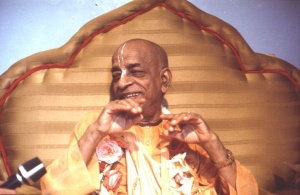CC Madhya 18.99 (1975)

A.C. Bhaktivedanta Swami Prabhupada
TEXT 99
- bhaṭṭācārya tabe kahe prabhura caraṇe
- 'ājñā deha', yāi' kari kṛṣṇa daraśane!'
SYNONYMS
bhaṭṭācārya—Balabhadra Bhaṭṭācārya; tabe—at that time; kahe—says; prabhura caraṇe—at the lotus feet of Śrī Caitanya Mahāprabhu; ājñā deha'-please give permission; yāi'-going; kari kṛṣṇa daraśane—I shall see Lord Kṛṣṇa directly.
TRANSLATION
At that time Balabhadra Bhaṭṭācārya placed a request at the lotus feet of Śrī Caitanya Mahāprabhu. He said, "Please give me permission to go see Lord Kṛṣṇa directly."
PURPORT
The puzzled people who visited Śrī Caitanya Mahāprabhu were actually seeing Lord Kṛṣṇa, but they were mistaken in thinking that Lord Kṛṣṇa had come to Kālīya Lake. They all said that they had seen Kṛṣṇa directly performing His pastimes on the hood of the serpent Kālīya and that the jewels on Kālīya's hoods were blazing brilliantly. Because they were speculating with their imperfect knowledge, they saw Śrī Caitanya Mahāprabhu as an ordinary human being and a boatman's light in the lake as Kṛṣṇa. One must see things as they are through the mercy of a spiritual master; otherwise if one tries to see Kṛṣṇa directly, he may mistake an ordinary man for Kṛṣṇa or Kṛṣṇa for an ordinary man. Everyone has to see Kṛṣṇa according to the verdict of Vedic literatures presented by the self-realized spiritual master. A sincere person is able to see Kṛṣṇa through the transparent via medium of Śrī Gurudeva, the spiritual master. Unless one is enlightened by the knowledge given by the spiritual master, he cannot see things as they are, even though he remains constantly with the spiritual master. This incident at Kālīya-daha is very instructive for those eager to advance in Kṛṣṇa consciousness.